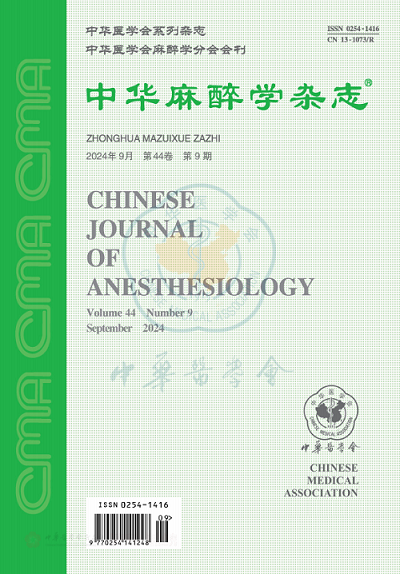Efficacy of ultrasound-guided caudal epidural block for postoperative analgesia in infants undergoing lobectomy under general anesthesia
Q4 Medicine
引用次数: 0
Abstract
Objective To evaluate the efficacy of ultrasound-guided caudal epidural block for postoperative analgesia in the infants undergoing lobectomy under general anesthesia. Methods Sixty American Society of Anesthesiology physical status Ⅱ or Ⅲ pediatric patients of both sexes, aged 1-3 yr, weighing 10-16 kg, scheduled for elective lobectomy under general anesthesia, were divided into 2 groups (n=30 each) using a random number table method: control group (group C) and epidural block group (group E). Caudal epidural block was performed under ultrasound guidance after induction of general anesthesia and at 15 min before surgery in group E. An epidural catheter was inserted at T6, 7 interspace, 0.1% ropivacaine 1 mg/kg was injected at 5 min after injecting 1% lidocaine 3 ml, the diffusion of epidural fluid was controlled at T3-10, and the epidural catheter was then removed.An analgesia pump was connected at the end of the surgery in two groups.Pain was evaluated using Face Legs Activity Cry Consolability scale.When Face Legs Activity Cry Consolability scale score>3, the pump was pressed.When pain was still unrelieved 5 min later, sufentanil 0.1-0.2 μg/kg was intravenously injected.The patients were followed up for 48 h after operation, and the requirement for additional remifentanil and sufentanil, and the occurrence of postoperative nausea and vomiting, respiratory depression, hypoxemia and over-sedation was recorded.The number of pressing times, extubation time and duration of intensive care unit stay were also recorded.Pain at 1 and 2 days after operation was evaluated using the Postoperative Pain Measure for Parents. Results Compared with group C, the consumption of remifentanil, the number of pressing times and requirement for additional sufentanil were significantly decreased, the incidence of each index of the Postoperative Pain Masure for Patients was decreased at 1 day after surgery, the extubation time and duration of intensive care unit stay were shortened, and the incidence of nausea and vomiting and over-sedation was decreased in group E (P<0.05). Conclusion Ultrasound-guided caudal epidural block provides better efficacy and fewer side effects for postoperative analgesia in the infants undergoing lobectomy under general anesthesia. Key words: Analgesia, epidural; Analgesia, postoperative; Ultrasound-guided; Child; Pneumonectomy超声引导硬膜外尾部阻滞用于全麻下婴儿肺叶切除术后镇痛的疗效
目的评价超声引导下硬膜外尾侧阻滞用于全麻下婴儿肺叶切除术后镇痛的效果。方法采用随机数表法将60例美国麻醉学学会身体状况Ⅱ或Ⅲ级儿童患者,年龄1-3岁,体重10-16kg,计划在全麻下进行选择性肺叶切除术,分为2组(每组30例):对照组(C组)和硬膜外阻滞组(E组)。E组在全麻诱导后和手术前15min在超声引导下进行尾部硬膜外阻滞。在T6,7间隙插入硬膜外导管,在注射1%利多卡因3ml后5min注射0.1%罗哌卡因1mg/kg,在T3-10控制硬膜外液的扩散,然后取出硬膜外导管。两组在手术结束时连接镇痛泵。疼痛使用脸腿活动哭闹安慰量表进行评估。当脸腿活动哭泣可操作性量表得分>3时,按下泵。5分钟后疼痛仍未缓解时,静脉注射舒芬太尼0.1-0.2μg/kg。术后随访48小时,记录患者对瑞芬太尼和舒芬太尼的额外需求,以及术后恶心呕吐、呼吸抑制、低氧血症和过度镇静的发生情况。还记录了按压次数、拔管时间和重症监护室住院时间。使用父母术后疼痛测量法评估术后1天和2天的疼痛。结果与C组相比,瑞芬太尼用量、按压次数和对额外舒芬太尼的需求均显著降低,术后1天患者术后疼痛伪装各指标发生率降低,拔管时间和重症监护室住院时间缩短,结论超声引导下硬膜外阻滞用于全麻下婴儿肺叶切除术后镇痛效果好,副作用少。关键词:镇痛、硬膜外;术后镇痛;超声引导;儿童;肺切除术
本文章由计算机程序翻译,如有差异,请以英文原文为准。
求助全文
约1分钟内获得全文
求助全文

 求助内容:
求助内容: 应助结果提醒方式:
应助结果提醒方式:


